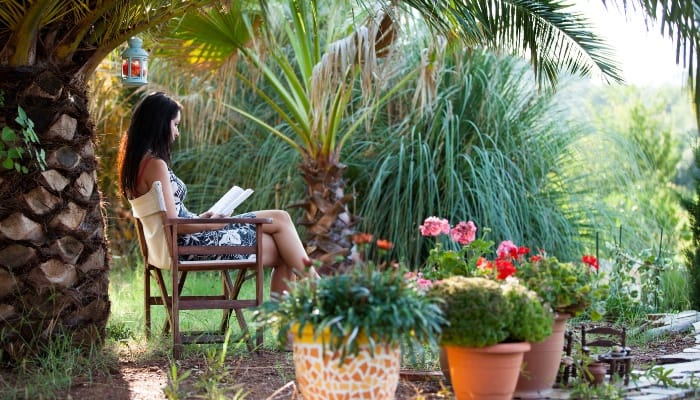Here are some of the top low-maintenance plants that are perfect for Florida:
- Sweet Williams
- Gaillardias
- Pentas
- Zinnias
- Croton
- Firebush
- Podocarpus
- Hibiscus
- Blue Daze
- Creeping Phlox
Each plant has specific characteristics and preferences. Before choosing your plants, consider the overall effect you want to achieve, and evaluate your property carefully for lighting, space, soil condition, and access to water.
Benefits of Choosing Low-Maintenance Plants for Florida
Low-maintenance plants are often well-suited to Florida’s climate and are drought-tolerant, which is particularly important in Florida where water conservation is often a concern.
Many low-maintenance plants generally require less care, such as pruning, fertilizing, and pest control.
They are often hardy and resistant to pests and diseases as well.
Additionally, many native low-maintenance plants support local ecosystems, attracting native wildlife such as birds, butterflies, and bees to your garden.
Factors To Consider
Considering the warm and humid Florida climate, choosing plants adapted to the specific Hardiness Zones and sun exposure of the region is crucial.
Additionally, awareness of soil composition, water availability, and the promotion of native plants for biodiversity and low maintenance are key considerations.
Resistance to local pests and diseases, the level of maintenance desired, aesthetic preferences, and adherence to local regulations also play vital roles in making well-informed plant selections.
What To Look For
When selecting low-maintenance plants for Florida gardens, opt for drought-tolerant plants and heat-resistant species able to withstand Florida’s warm temperatures.
Choose native plants for their adaptability, low maintenance, and ability to support local biodiversity.
Fill your yard with plants that have a natural resistance to common pests and diseases, and consider their ability to thrive in diverse soil types, salt exposure in coastal areas, and various microclimates.
Additionally, select plants with a mix of colors, textures, and bloom times.
Low-Maintenance Flowers
The beautiful choices detailed below aren’t only easy to care for, but they also thrive in the Florida climate. Add a pop of color and beauty to your garden without the hassle of high maintenance.
Sweet Williams

Sweet Williams (Dianthus barbatus) have a charming appearance with compact clusters of fringed petals in colors like pink, red, and white. While not native to Florida, they are well-adapted to the climate.
Typically reaching a height of 12-18 inches, the long-lasting blooms emit a sweet fragrance, attract butterflies, and bloom in spring. They thrive in full sun but can tolerate partial shade.
Coreopsis

Coreopsis, also known as tickseed, are hardy flowers that require minimal care. They feature bright yellow or orange blooms with a daisy-like appearance.
Some varieties are native to Florida and typically grow to heights ranging from 1 to 3 feet.
Drought-tolerant and attractive to pollinators like bees and butterflies, coreopsis blooms from spring to fall and flourishes in full sun.
Knockout Roses

Knockout roses are compact shrub roses known for continuous blooms in various colors, including red, pink, and yellow.
They adapt well to Florida’s climate and tend to grow with a naturally compact, bushy habit that does not require heavy or frequent pruning.
With a typical height of 3-4 feet, Knockout roses are known for their long blooming season, producing abundant flowers from spring until fall when planted in full sun.
They’re resistant to diseases and pests, and they are quite drought-tolerant.
Black-Eyed Susans
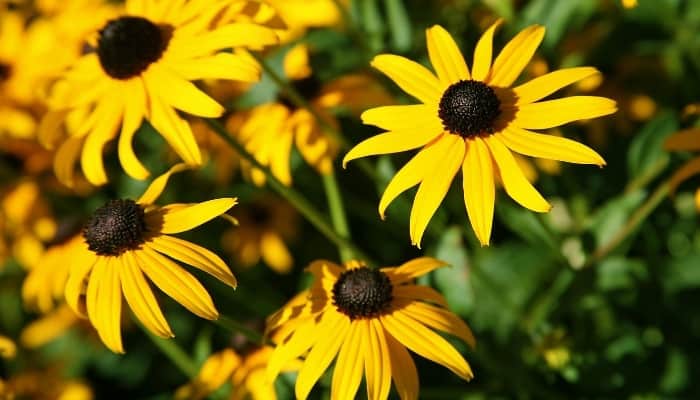
Black-eyed Susans (Rudbeckia hirta) display bright golden-yellow petals with a dark central cone. Native to Florida, these flowers reach a height of 2 to 3 feet.
Drought-tolerant and attractive to butterflies, black-eyed Susans bloom from summer to fall, preferring full sun but tolerating partial shade.
These hardy plants have excellent disease and pest resistance, reducing the need for pesticides or constant monitoring.
Gaillardia
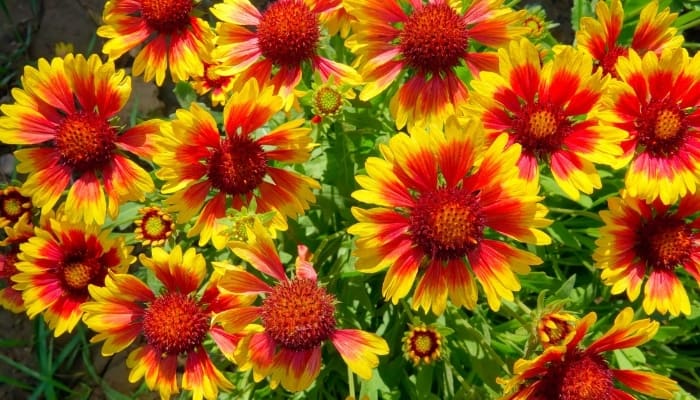
Gaillardia (Gaillardia pulchella), also known as blanket flower, showcases vibrant red, orange, or yellow petals with a central disk.
These beautiful flowers are native to North and South America and thrive in the warm and sunny climate of Florida, typically reaching 1-2 feet in height.
Gaillardia blooms from late spring to fall and thrives in full sun. These flowers are drought-tolerant and can survive in sandy or well-drained soil.
Gaillardia also attracts pollinators like butterflies and bees, making them a great addition to any wildlife-friendly garden.
Simply plant them in a sunny spot, water occasionally, and enjoy their stunning blooms all season long.
Pentas
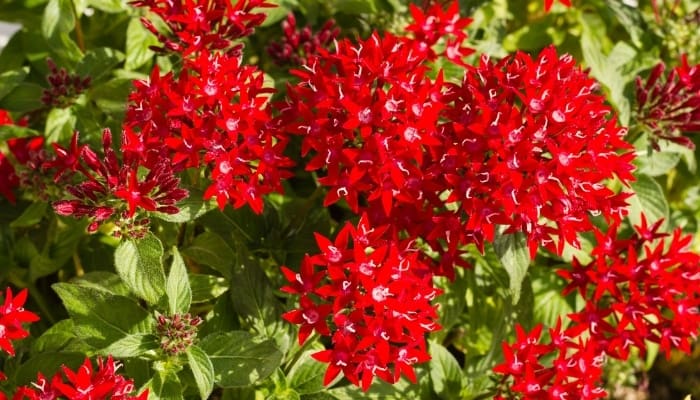
Pentas (Pentas lanceolata), also known as Egyptian stars, feature clusters of star-shaped flowers in shades of pink, red, lavender, and white.
While not native, they thrive in Florida’s climate, reaching heights of 2 to 4 feet.
Pentas attract butterflies and hummingbirds, blooming year-round in warm climates. They prefer full sun to partial shade.
With their ability to tolerate heat and drought and their resistance to pests and diseases, pentas are a great addition to any low-maintenance landscape in Florida.
Zinnias
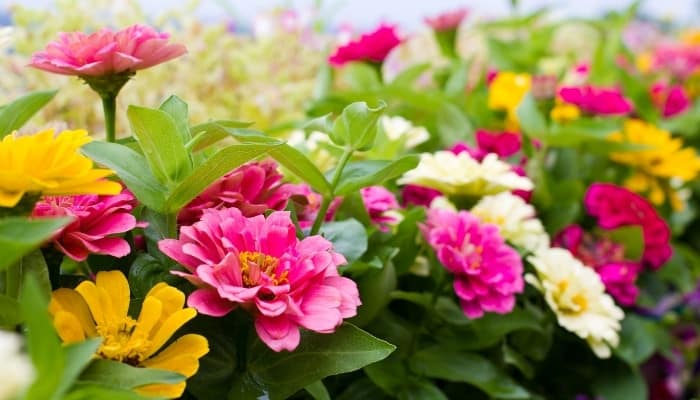
Zinnias contribute vibrant splashes of color with their diverse blooms, available in a wide range of shades and shapes.
Although not native, zinnias do well in the Florida climate and can withstand the heat and humidity of the region.
Heights vary, with some shorter dwarf varieties suitable for borders and taller ones better suited for background planting.
Zinnias are easy to grow, attract butterflies and bees, and bloom from spring to frost.
These flowers thrive in full sun, are drought-tolerant, and can survive in various soil types. Occasionally trimming off the spent blooms will encourage increased flower production.
Marigolds
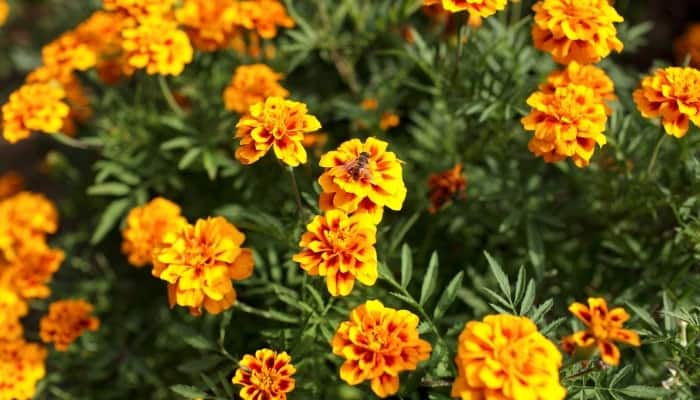
Marigolds are cheerful and low-maintenance flowers that add warmth to your Florida garden. Available in shades of orange, yellow, and gold, marigolds are not native but flourish in the state’s warm climate.
With a typical height ranging from 6 inches to 2 feet, marigolds are pest-resistant and easy to grow. They bloom from spring to fall but prefer full sun exposure for optimal growth.
Marigolds are known for their ability to deter pests, making them a natural pest control option for your garden. They also have a long blooming season, providing you with beautiful flowers throughout the year.
Morning Glories

Morning glories are fast-growing vines with trumpet-shaped flowers that remain open all morning long. While some varieties are native, all types adapt well to Florida’s conditions.
Vines can reach impressive lengths of 10 to 15 feet, creating a charming and natural screen.
Morning glories are known for their fast growth and ability to cover fences, trellises, and walls, adding a touch of whimsy to your outdoor space.
Morning glories attract butterflies, and they bloom from spring to fall, but these plants need full sun for optimal growth and flowering.
Low-Maintenance Trees and Shrubs
The following perennial plants are known for their durability and ability to grow well in the Florida climate with minimal care.
Whether you’re looking to add some color or create a natural privacy screen, these low-maintenance trees and shrubs will surely enhance your outdoor space without requiring much maintenance.
Croton

Croton (Codiaeum variegatum) is a vibrant and low-maintenance shrub known for its colorful and variegated foliage. Although they are not native plants, crotons adapt well to the warm climate.
They can grow to various heights, depending on the variety. With their striking leaves in shades of red, orange, and yellow, crotons add a tropical flair tony garden or yard. These shrubs prefer full to partial sun and well-drained soil.
Croton can tolerate both drought and heat and is also relatively pest-resistant, which means you won’t have to worry about constant monitoring or spraying.
However, it’s important to note that croton isn’t frost-tolerant, so it’s best to protect it during cold winter months.
Japanese Boxwood

Japanese boxwood (Buxus microphylla) is a versatile and evergreen shrub that requires minimal maintenance. Its compact nature and dense foliage of green leaves make it an excellent choice for hedges or borders.
These non-native shrubs typically reach a height of 4 to 6 feet. They thrive in partial to full shade, making them ideal for areas with limited sunlight.
Japanese boxwood is known for its ability to tolerate a wide range of growing conditions, including heat, humidity, and even salt spray. It requires minimal pruning and can be easily shaped into desired forms.
False Indigo Bush

False indigo bush (Amorpha fruticosa) is a native Florida shrub known for its low-maintenance qualities.
With feathery green foliage and fragrant spikes of blue flowers, it adds a touch of elegance to your yard. False indigo bushes can reach heights of 3 to 5 feet.
The false indigo bush thrives in full sun to partial shade and can tolerate a wide range of soil conditions. It’s drought-tolerant once established, reducing the need for frequent irrigation.
This versatile plant can be used as a hedge, border, or focal point in your landscape design.
Alexander Palm

Alexander palm (Archontophoenix alexandrae) is a low-maintenance palm tree that adds a tropical and graceful element. While not native, this palm can withstand the hot and humid Florida weather with ease.
These palms can reach heights of 20 to 30 feet, creating a striking focal point. With feather-like fronds and a slender trunk, the Alexander palm prefers full sun to partial shade.
Firebush

Firebush (Hamelia patens) is a native shrub that requires minimal care and rewards you with vibrant red-orange tubular flowers.
Growing to a height of 6 to 12 feet, firebush attracts hummingbirds and butterflies, making it a delightful addition to your space. It is drought-tolerant and thrives in full sun, making it well-suited for Florida gardens.
Coontie

Coontie (Zamia integrifolia) is a Florida native cycad that offers a unique and low-maintenance option for landscaping. With its fern-like appearance, coontie adds a touch of prehistoric charm to your garden.
These plants typically reach heights of 2 to 3 feet. Coontie is drought-tolerant and thrives in partial to full shade and a wide range of soil types. It’s a slow-growing plant, which means it won’t require frequent pruning or shaping.
Fun fact: Coontie is a host plant for the endangered Atala butterfly, making it a valuable addition to conservation efforts.
Podocarpus

Podocarpus, also known as the yew plum pine, is a versatile, low-maintenance evergreen shrub or tree that adapts well to Florida’s climate.
With dense foliage and a narrow, upright growth habit, podocarpus is suitable for hedges, screens, or as a standalone specimen.
Heights can vary depending on the specific variety, but all types of podocarpus thrive in full sun to partial shade.
It’s drought-tolerant and can tolerate a wide range of soil conditions, making it ideal for Florida’s unpredictable weather.
This plant requires minimal pruning and is resistant to pests and diseases, which reduces the need for constant maintenance.
Indian Hawthorn

Indian Hawthorn is a durable, low-maintenance shrub that adapts well to Florida’s growing conditions and adds year-round interest to your landscape.
It has glossy evergreen leaves and occasional clusters of pink or white flowers.
The Indian Hawthorn is a compact plant that can be used as a hedge, border, or foundation planting with heights ranging from 3 to 6 feet. These shrubs prefer full sun to partial shade.
Indian Hawthorne is also resistant to pests and diseases, making it a low-maintenance choice for your garden. It requires minimal pruning and can tolerate a variety of soil types.
Hibiscus
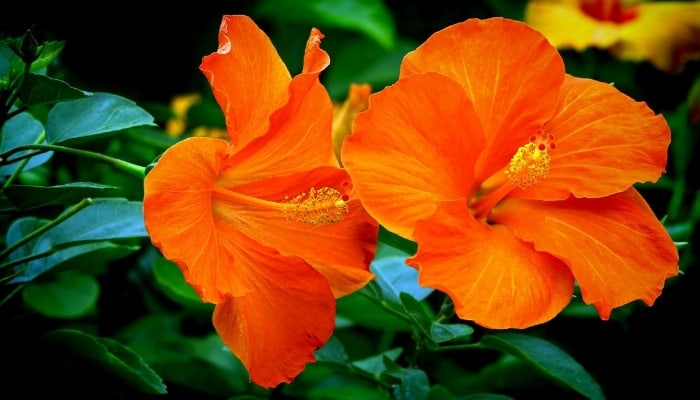
Hibiscus are iconic, low-maintenance flowering shrubs that thrive in Florida’s warm climate. With their large and showy blooms in shades of red, pink, yellow, and white, hibiscus adds a tropical touch to your landscape.
Heights can vary, with some reaching up to 15 feet. Hibiscus prefers full sun and well-drained soil. They can tolerate a variety of soil conditions and are resistant to most pests and diseases.
Crape Myrtles

Crape myrtles are versatile and low-maintenance flowering trees that add beauty to Florida landscapes.
They come in a variety of colors and sizes, from shrubs to small trees, allowing you to choose the perfect fit for your outdoor space.
Crape myrtles are drought-tolerant and thrive in the Florida heat, making them a great choice for our climate. Heights can range from 3 to 25 feet, depending on the variety.
These trees prefer full sun and well-drained soil. With their attractive bark and vibrant blooms, crape myrtles add a pop of color and visual interest to any garden.
Low-Maintenance Succulents
The succulents below are known for their ability to thrive in hot, dry conditions, making them perfect for creating a beautiful Florida landscape.
With minimal care and maintenance, you can enjoy their unique shapes and textures in your outdoor space.
Agave

Agave is a low-maintenance succulent known for its striking rosette form and variety of leaf colors and textures.
Agave plants, although most are not native, are ideal for Florida’s warm climate as they are drought-tolerant, do well in full sun, and require minimal water.
These succulents have thick, fleshy leaves that store water, allowing them to survive in hot and dry conditions.
These succulents come in various sizes, with some larger varieties suitable as focal points in your landscape.
Agave plants thrive in well-draining soil and prefer full sun, making them perfect for Florida’s sandy soil and abundant sunshine.
Sedum

Sedum, also known as stonecrop, is a diverse group of low-maintenance succulents that add texture and interest to your garden. Sedums are versatile additions to Florida gardens as they can be planted in containers, rock gardens, or as ground cover.
These succulents vary in size and shape, with some forming ground covers and others providing vertical interest. Sedums require minimal watering, do well in dry conditions, and can thrive in part shade or full sun.
Crown of Thorns

Crown of thorns (Euphorbia milii) is a low-maintenance succulent shrub known for its thick stems and colorful bracts in shades of red, pink, yellow, and white.
The crown of thorn plant typically reaches a height of 2 to 3 feet, producing clusters of small flowers surrounded by long-lasting bracts.
It thrives in the Florida climate, requiring little water and tolerating both full sun and partial shade.
Crown of thorns is also resistant to pests and diseases, making it an ideal choice for those with little spare time.
To keep this succulent looking its best, simply provide well-draining soil, occasional irrigation, and regular pruning to control its size and shape.
Low-Maintenance Ground Covers
With their ability to spread and fill in empty spaces, the following ground covers will help you achieve a lush and hassle-free garden.
Liriope

Liriope is a versatile, low-maintenance ground cover that adds texture and greenery to your landscape.
With strappy leaves and occasional spikes of small flowers, liriope is well-suited to Florida’s climate and known for its ability to withstand harsh weather conditions.
Heights can vary depending on the specific variety, but liriope has the ability to spread quickly, filling in bare areas and preventing weed growth. It requires minimal watering and can thrive in both sun and shade.
Blue Daze

Blue Daze (Evolvulus glomeratus) is a low-maintenance groundcover celebrated for its trailing habit and stunning blue flowers. Blue Daze typically reaches a height of 6 to 12 inches, forming a dense mat of silvery-green foliage.
With its spreading habit, Blue Daze can quickly fill in empty spaces and provide a lush carpet of color. Blue Daze thrives in full sun or partial shade, is drought-tolerant, and only needs occasional watering.
Creeping Phlox

Creeping phlox (Phlox subulata), known for its cascading habit and masses of small, fragrant flowers, is a beautiful plant that spreads quickly, forming a dense carpet of vibrant flowers. It typically reaches a height of 6 to 12 inches.
With its ability to thrive in various soil types and tolerate full sun or partial shade, creeping phlox is a versatile choice for any garden.
It requires minimal care and is drought-tolerant. Its vibrant blooms attract butterflies and bees, adding a touch of natural beauty to your outdoor space.

